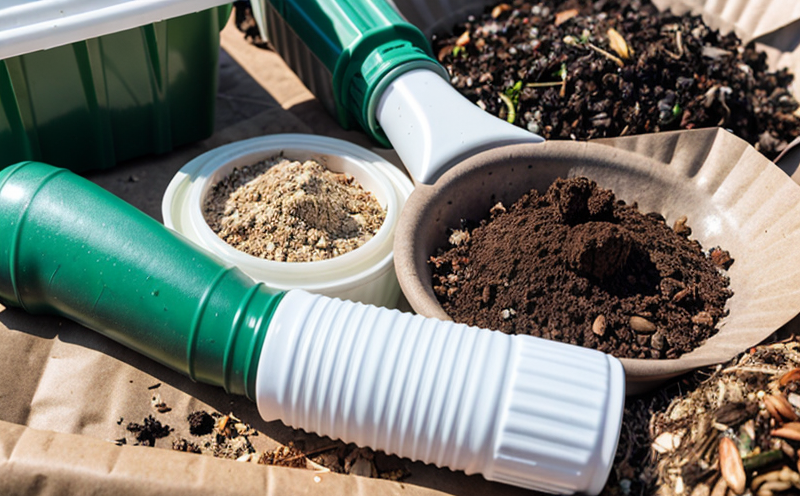EN 13715 Water Holding Capacity of Compostable Waste
The European standard EN 13715 specifies a method for determining the water holding capacity (WHC) of compostable waste materials. This test is critical in evaluating the performance and biodegradability properties of compostable products, particularly those intended to be used as agricultural mulch films or other soil amendments.
The standard applies specifically to compostable plastic films and non-woven materials that are designed for use in agriculture where they will come into contact with soil. The test measures the amount of water a specimen can hold when wetted under specific conditions, providing insights into its potential to retain moisture over time. This property is vital because it influences how effectively these products contribute to soil hydration and fertility.
The test procedure involves conditioning the sample in controlled humidity and temperature environments for 24 hours, then weighing it before and after being soaked in distilled water for one hour at a specified temperature (typically room temperature). The difference between initial and final weights provides an accurate measure of WHC. Compliance with this standard ensures that products meet environmental performance requirements set by regulatory bodies.
Understanding the water holding capacity is essential not only from a functional perspective but also environmentally speaking. Products that perform well in terms of WHC contribute positively to sustainable agricultural practices by enhancing soil moisture retention, which can lead to reduced irrigation needs and improved crop yields. Additionally, better moisture management through such materials supports biodiversity and overall ecosystem health.
For quality managers looking to ensure their compostable waste products meet regulatory standards, this test offers crucial data points. Compliance with EN 13715 helps maintain brand reputation by demonstrating commitment to environmental responsibility. Moreover, it allows companies to stay ahead in the rapidly evolving market for biodegradable materials used in agriculture.
Quality assurance teams benefit greatly from understanding how their products behave under these conditions since non-compliance could result in legal issues or damage to consumer trust. By adhering to this standard, organizations demonstrate leadership in sustainable development within their industry sectors.
Applied Standards
The primary application of EN 13715 lies in assessing compostable plastics and other biodegradable materials used as mulch films or soil amendments. These products must comply with stringent environmental regulations aimed at reducing waste sent to landfills, promoting circular economy principles, and fostering sustainable agriculture.
- EN 13432: This broader European standard outlines requirements for packaging that can be composted under industrial conditions. Compliance ensures that the tested materials meet all necessary criteria for biodegradability, disintegration, energy recovery, and lack of toxic residue.
- ASTM D6400: Another widely recognized American standard for plastics intended for use in home or industrial composting systems. It provides similar guidelines regarding biodegradation rates but focuses more specifically on consumer-facing products like bags and containers.
The combination of these standards ensures comprehensive coverage across different sectors where compostable waste plays a crucial role. By adhering to both EN 13715 and other relevant international standards, manufacturers can confidently claim compliance with global best practices in sustainable resource management.
Scope and Methodology
The scope of EN 13715 is limited strictly to compostable plastic films and non-woven materials. These products are typically used as agricultural mulch films or other soil amendments, intended to come into direct contact with the earth during their life cycle.
Before conducting the test, samples must be conditioned in a controlled environment for at least 24 hours. This ensures uniformity across all specimens being tested, eliminating any discrepancies due to varying moisture levels or temperature effects. Once conditioned, each sample is weighed accurately using analytical balances capable of detecting differences down to milligram precision.
The next step involves soaking the samples in distilled water at a specified temperature (usually room temperature) for one hour. During this period, the specimens absorb as much water as possible without exceeding their maximum capacity. After soaking, they are again weighed immediately after removal from the liquid to determine the weight gain resulting solely from moisture absorption.
Calculating WHC requires subtracting the dry weight of each sample from its wetted weight. The result represents the percentage increase in mass attributed directly to water uptake. Acceptance criteria for WHC vary depending on product type and intended application, so it's important to consult specific standards or guidelines provided by regulatory bodies.
This rigorous process allows manufacturers and researchers to accurately assess the performance characteristics of their compostable waste materials under real-world conditions. Compliance with EN 13715 not only enhances product quality but also contributes significantly towards meeting broader sustainability goals related to resource efficiency and environmental protection.
Environmental and Sustainability Contributions
The use of compostable waste products in agriculture offers numerous benefits for the environment. By enhancing soil moisture retention, these materials help reduce irrigation requirements, leading to water savings which are particularly valuable in regions facing drought conditions or stringent water usage restrictions.
- Water Conservation: Improved water retention capabilities mean less frequent watering is needed, reducing overall demand on freshwater resources. This is especially beneficial for large-scale farms and greenhouses relying heavily on irrigation systems.
- Biodiversity Support: Enhanced soil health fosters better growing conditions for plants, encouraging greater biodiversity within cultivated areas. Healthier soils support diverse flora and fauna, contributing positively to ecosystem stability.
- Solid Waste Management: Compostable waste products provide an alternative to traditional landfill disposal methods, diverting biodegradable materials away from landfills where they would otherwise generate methane—a potent greenhouse gas during decomposition processes.
Incorporating compostable waste into agricultural practices aligns with broader sustainability initiatives aimed at minimizing environmental impact. It supports circular economy principles by ensuring that waste products are reused rather than discarded, thereby promoting more sustainable resource cycles.





